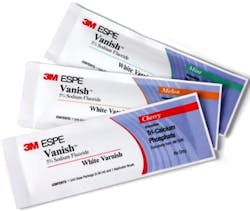5 suggestions for making fluoride varnish applications simple and effective
By Ellen Neuenfeldt, RDH, BS
For time-pressed dental professionals, any innovation that can make a procedure faster and easier is welcome. Hygienists need shortcuts that can help free up time for patient education and relationship building, while not compromising on delivering great patient care.Applying fluoride varnish is a procedure that can be relatively simple, or complicated, depending on the specific product. Some varnishes require that the teeth are dried for application, and must be applied meticulously to every tooth surface. However, a better alternative is available: 3M ESPE Vanish 5% Sodium Fluoride White Varnish with Tri-Calcium Phosphate. 1.) A quick and efficient application process
Tooth surfaces need only be toothbrush clean, and they should be moist. The application process for this varnish is completed in three easy steps:
Hygienists will notice a difference in Vanish Varnish compared to other varnishes; it is very tenacious, which helps it to stay in place on the teeth. For a full-mouth application, a thin film of varnish is painted on in sweeping horizontal brushstrokes across multiple teeth. The patient can then close his or her mouth to set the varnish. When the varnish comes into contact with saliva, it quickly and uniformly sets onto tooth surfaces — keeping fluoride and calcium in contact with the teeth until it is brushed off. 3.) Better flowability — including interproximal areas
What’s most interesting is what happens next; the varnish beneath the set surface layer will continue to flow from treated to untreated surfaces on the teeth for at least four hours. This flowing action is the reason that Vanish varnish does not need to be meticulously applied to every surface. It continues flowing after application, which helps it reach areas other varnishes might miss. When treating the whole mouth, the hygienist only has to apply the varnish to the buccal and occlusal surfaces of teeth, and it will flow on its own to the lingual surfaces. 4.) An optimized formula for more protection
The formula of the varnish also helps it deliver maximum results. This varnish not only contains sodium fluoride but also innovative Tri-Calcium Phosphate (TCP). After the varnish is applied and comes in contact with saliva, it releases calcium and fluoride. As the varnish continues flowing across tooth surfaces, it is exposed to even more saliva, causing the release of additional fluoride and calcium which can continue for up to 24 hours. Vanish varnish also provides patients immediate and long-lasting relief from hypersensitivity due to its ability to penetrate and seal dentin tubules.5.) Patient convenience and satisfaction
This simple application process makes a fluoride treatment quick and easy for both the clinician and the patient. Patients also appreciate that they can eat and drink immediately after the application. The varnish is virtually invisible, and is available in a variety of flavors to please both children and adults, including cherry, melon, and mint. With a formula that works so effectively and is simple to apply, Vanish varnish gives hygienists a valuable treatment tool in which to increase efficiency and protect the teeth of all generations of patients, from young children to older adults.
For time-pressed dental professionals, any innovation that can make a procedure faster and easier is welcome. Hygienists need shortcuts that can help free up time for patient education and relationship building, while not compromising on delivering great patient care.Applying fluoride varnish is a procedure that can be relatively simple, or complicated, depending on the specific product. Some varnishes require that the teeth are dried for application, and must be applied meticulously to every tooth surface. However, a better alternative is available: 3M ESPE Vanish 5% Sodium Fluoride White Varnish with Tri-Calcium Phosphate. 1.) A quick and efficient application process
Tooth surfaces need only be toothbrush clean, and they should be moist. The application process for this varnish is completed in three easy steps:
- The unit dose package is opened and dispensed
- The varnish is mixed with the applicator brush
- It is then applied to the treatment area; full mouth application should take no longer than 30 seconds
Hygienists will notice a difference in Vanish Varnish compared to other varnishes; it is very tenacious, which helps it to stay in place on the teeth. For a full-mouth application, a thin film of varnish is painted on in sweeping horizontal brushstrokes across multiple teeth. The patient can then close his or her mouth to set the varnish. When the varnish comes into contact with saliva, it quickly and uniformly sets onto tooth surfaces — keeping fluoride and calcium in contact with the teeth until it is brushed off. 3.) Better flowability — including interproximal areas
What’s most interesting is what happens next; the varnish beneath the set surface layer will continue to flow from treated to untreated surfaces on the teeth for at least four hours. This flowing action is the reason that Vanish varnish does not need to be meticulously applied to every surface. It continues flowing after application, which helps it reach areas other varnishes might miss. When treating the whole mouth, the hygienist only has to apply the varnish to the buccal and occlusal surfaces of teeth, and it will flow on its own to the lingual surfaces. 4.) An optimized formula for more protection
The formula of the varnish also helps it deliver maximum results. This varnish not only contains sodium fluoride but also innovative Tri-Calcium Phosphate (TCP). After the varnish is applied and comes in contact with saliva, it releases calcium and fluoride. As the varnish continues flowing across tooth surfaces, it is exposed to even more saliva, causing the release of additional fluoride and calcium which can continue for up to 24 hours. Vanish varnish also provides patients immediate and long-lasting relief from hypersensitivity due to its ability to penetrate and seal dentin tubules.5.) Patient convenience and satisfaction
This simple application process makes a fluoride treatment quick and easy for both the clinician and the patient. Patients also appreciate that they can eat and drink immediately after the application. The varnish is virtually invisible, and is available in a variety of flavors to please both children and adults, including cherry, melon, and mint. With a formula that works so effectively and is simple to apply, Vanish varnish gives hygienists a valuable treatment tool in which to increase efficiency and protect the teeth of all generations of patients, from young children to older adults.
Ellen S. Neuenfeldt, RDH, BS, is Professional Relations Manager for 3M ESPE.

